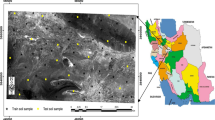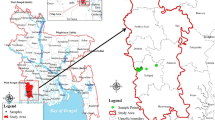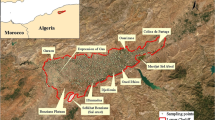Abstract
Soil salinity in the Aral Sea Basin is one of the major limiting factors of sustainable crop production. Leaching of the salts before planting season is usually a prerequisite for crop establishment and predetermined water amounts are applied uniformly to fields often without discerning salinity levels. The use of predetermined water amounts for leaching perhaps partly emanate from the inability of conventional soil salinity surveys (based on collection of soil samples, laboratory analyses) to generate timely and high-resolution salinity maps. This paper has an objective to estimate the spatial distribution of soil salinity based on readily or cheaply obtainable environmental parameters (terrain indices, remote sensing data, distance to drains, and long-term groundwater observation data) using a neural network model. The farm-scale (∼15 km2) results were used to upscale soil salinity to a district area (∼300 km2). The use of environmental attributes and soil salinity relationships to upscale the spatial distribution of soil salinity from farm to district scale resulted in the estimation of essentially similar average soil salinity values (estimated 0.94 vs. 1.04 dS m−1). Visual comparison of the maps suggests that the estimated map had soil salinity that was uniform in distribution. The upscaling proved to be satisfactory; depending on critical salinity threshold values, around 70–90% of locations were correctly estimated.
Similar content being viewed by others
References
Abdullaev, U. (2003). Republic of Uzbekistan. Land degradation assessment in drylands (LADA). Research and Design Institute Uzgipromeliovodkhoz, pp. 43.
Akramkhanov, A. (2005). The spatial distribution of soil salinity: Detection and prediction. ZEF Series in Ecology and Development No. 32, Bonn, Germany, University of Bonn.
Akramkhanov, A., Sommer, R., Martius, C., Hendrickx, J. M. H., & Vlek, P. L. G. (2008). Comparison and sensitivity of measurement techniques for spatial distribution of soil salinity. Irrigation and Drainage Systems, 22, 115–126.
Bennett, D. L., George, R. J., & Ryder, A. (1995). Soil salinity assessment using the EM38: Field operating instructions and data interpretation. Miscellaneous Publication 4/95, Western Australia, Department of Agriculture.
Bouma, J., & Hoosbeek, M. R. (1996). The contribution and importance of soil scientists in interdisciplinary studies dealing with land. In R. J. Wagenet, & J. Bouma (Eds.), The role of soil science in interdsciplinary research (pp. 1–15). SSSA Special Publication 45.
Bowden, G. J., Maier, H. R., & Dandy, G. C. (2002). Optimal division of data for neural network models in water resources applications. Water Resources Research, 38, 1–11.
Cherkassky, V., & Mulier, F. (1998). Learning from data: Concepts, theory, and methods. U.S.A.: Wiley.
Department for Natural Resources (2004). DNR random sample generator. Release 2.2. Minnesota: Department for Natural Resources.
Eklund, P. W., Kirkby, S. D., & Salim, A. (1998). Data mining and soil salinity analysis. International Journal of Geographical Information Science, 12, 247–268.
Evans, F. H., & Caccetta, P. A. (2000). Broad-scale spatial prediction of areas at risk from dryland salinity. Cartography, 29, 33–40.
Hoosbeek, M. R., & Bouma, J. (1998). Obtaining soil and land quality indicators using research chains and geostatistical methods. Nutrient Cycling in Agroecosystems, 50, 35–50.
Kachanoski, R. G., Rolston, D. E., & de Jong, E. (1985). Spatial and spectral relationships of soil properties and microtopography: I. Density and thickness of A horizon. Soil Science Society of America Journal, 49, 804–812.
Lavado, F., Maneta, M., & Schnabel, S. (2006). Prediction of near-surface soil moisture at large scale by digital terrain modelling and neural networks. Environmental Monitoring and Assessment, 121(1–3), 211–230.
Leij, F. J., Romano, N., Palladino, M., Schaap, M. G., & Coppola, A. (2004). Topographic attributes to predict soil hydraulic properties along a hillslope transect. Water Resources Research, 40, W02407.
Lesch, S. M., Strauss, D. J., & Rhoades, J. D. (1995). Spatial prediction of soil salinity using electromagnetic induction techniques. 2. An efficient spatial sampling algorithm suitable for multiple linear regression model identification and estimation. Water Resources Research, 31, 387–398.
Maier, H. R., & Dandy, G. C. (1999). Empirical comparison of various methods for training feed-forward neural networks for salinity forecasting. Water Resources Research, 35, 2591–2596.
McBratney, A. B., Odeh, I. O. A., Bishop, T. F. A., Dunbar, M. S., & Shatar, T. M. (2000). An overview of pedometric techniques for use in soil survey. Geoderma, 97, 293–327.
McKenzie, N. J., & Ryan, P. J. (1999). Spatial prediction of soil properties using environmental correlation. Geoderma, 89, 67–94.
McKenzie, N. J., Gessler, P. E., Ryan, P. J., & O’Connell, D. A. (2000). The role of terrain analysis in soil mapping. In J. P. Wilson, & J. C. Gallant (Eds.), Terrain analysis: Principles and applications (p. 245–265). New York: Wiley.
Moore, I. D., Gessler, P. E., Nielsen, G. A., & Peterson, G. A. (1993). Soil attribute prediction using terrain analysis. Soil Science Society of America Journal, 57, 443–452.
Park, S. J., McSweeney, K., & Lowery, B. (2001). Identification of the spatial distribution of soils using a process-based terrain characterization. Geoderma, 103, 249–272.
Patel, R. M., Prasher, S. O., Goel, P. K., & Bassi, R. (2002). Soil salinity prediction using artificial neural networks. Journal of the American Water Resources Association, 38, 91–100.
Persson, M., Sivakumar, B., Berndtsson, R., Jacobsen, O. H., & Schjonning, P. (2002). Predicting the dielectric constant–water content relationship using artificial neural networks. Soil Science Society of America Journal, 66, 1424–1429.
Principe, J. C., Euliano, N. R., & Lefebvre, C. W. (2000). Neural and adaptive systems: Fundamentals through simulations. New York: Wiley.
Rhoades, J. D., Chanduvi, F., & Lesch, S. (1999). Soil salinity assessment: Methods and interpretation of electrical conductivity measurements. FAO Irrigation and Drainage Paper 57.
Triantafilis, J., Odeh, I. O. A., & McBratney, A. B. (2001). Five geostatistical models to predict soil salinity from electromagnetic induction data across irrigated cotton. Soil Science Society of America Journal, 65, 869–878.
Wang, D., Wilson, C., & Shannon, M. C. (2002). Interpretation of salinity and irrigation effects on soybean canopy reflectance in visible and near-infrared spectrum domain. International Journal of Remote Sensing, 23, 811–824.
Zevenbergen, L. W., & Thorne, C. R. (1987). Quantitative analysis of land surface topography. Earth Surface Processes and Landforms, 12, 47–56.
Zhu, A. X. (2000). Mapping soil landscape as spatial continua: The neural network approach. Water Resources Research, 36, 663–677.
Author information
Authors and Affiliations
Corresponding author
Rights and permissions
About this article
Cite this article
Akramkhanov, A., Vlek, P.L.G. The assessment of spatial distribution of soil salinity risk using neural network. Environ Monit Assess 184, 2475–2485 (2012). https://doi.org/10.1007/s10661-011-2132-5
Received:
Accepted:
Published:
Issue Date:
DOI: https://doi.org/10.1007/s10661-011-2132-5




